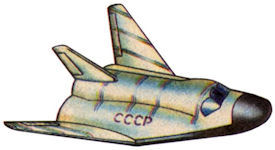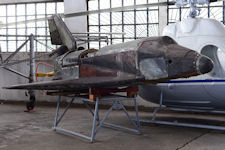BOR (Unmanned Orbital Rocketplane)
 In order to refine the results of wind tunnel research, the stability and controllability characteristics of the orbital aircraft (OS) of the Spiral airspace system at various flight sites and the study of the properties of new thermal protection materials (TZP) envisaged in the design of the future orbital aircraft, models in scales 1: 3 and 1: 2 series BOR (Unmanned Orbital Rocketplane).
In order to refine the results of wind tunnel research, the stability and controllability characteristics of the orbital aircraft (OS) of the Spiral airspace system at various flight sites and the study of the properties of new thermal protection materials (TZP) envisaged in the design of the future orbital aircraft, models in scales 1: 3 and 1: 2 series BOR (Unmanned Orbital Rocketplane).
This spacecraft was used to investigate the hypersonic aerodynamic characteristics and heat shield materials of the manned Spiral OS lifting body, 1:3 and 1:2 scale models of the OS were to be built. Unlike the full-scale model, these were had fixed wings and were designated BOR (unpiloted orbital rocketplane). BOR-1, -2, and -3 were increasingly sophisticated models of the configuration, flown on suborbital trajectories.
So, BOR-1 was made in length of 3 m in a scale of 1: 3 OS made entirely of wood and its weight was 800 kg. BOR-1 was launched by the Cosmos-2 LV (11K65) on July 15, 1969, to a height of 100 km and, naturally, burned at the entrance to the atmosphere at a speed of 13,000 km / h. But before the beginning of the burn, at a height of 60-70 km, radiotelemetry brought to the Earth a lot of valuable information, the main conclusion of which was the confidence in the very possibility of a stable controlled descent of the bearing body of the selected shape.
BOR-2 and BOR-3, manufactured on a scale of 1: 3 and 1: 2 OS, respectively, were already made of metal and had programmed control. These vehicles were launched into space along a ballistic trajectory from Kapustin Yar towards the polygon in Sary-Shagan (Kazakhstan) by the same carrier (11K65).
After the cancellation of Spiral in favor of the Buran, BOR-4 subscale spaceplanes were used to test heat shield materials developed for Buran. Certain essential tests of these heat shield materials could not be done in the lab. These included interaction with the plasma sheath during re-entry, chemical disassociation effects, etc. The BOR-4 was clad in 118 tiles of the type developed for Buran as well as carbon-carbon nose cap and leading edge.
These BOR-4 unmanned orbiters were equipped with braking engines. After a circuit of the earth, the spacecraft would deorbit, perform a gliding re-entry, followed by parachute deployment, splashdown in the ocean, and recovery by Soviet naval forces. BOR-4 flew four successful test flights at speeds of from Mach 3 to 25 and altitudes of 30 to 100 km. These test flights confirmed the physical, chemical, and catalytic processes that operated on the selected heat shield materials in the re-entry plasma. BOR-4 also provided important data on the acoustic environment during launch and re-entry. Compared to the Spiral MiG 105-11 EPOS configuration, the BOR-4 had a flattened, wider body with a much smaller vertical stabilizer.
Substantially modified "BOR-4" served for the development of a new heat-protection system, close in characteristics to the Buran TZP. It was an unmanned experimental apparatus, being a reduced copy (1: 3) of a manned air and space aircraft developed earlier under the "Spiral" program, and was carried out according to the aerodynamic scheme "bearing body". It had the following characteristics: length 3.4 m, wingspan 2.6 m and weight 1074 kg in orbit and 795 kg after return. The device with a beveled up wing was equipped with gas stabilization engines, autonomous control units, a thermal shield and a discarded brake propulsion system for descent from orbit.
| Name | Kosmos 1374, BOR 4 | |
| Start Date ( UTC ): 03.06.1982 | ||
| Nation | USSR | |
| Manufacturer: | NPO Molnija | |
| Form | plane similar to tub-hull | |
| length | 3.86 m | |
| height over tail | 1.16 m | |
| span: | 2.88 m | |
| Initial mass | 1.450 kg | |
| mass BOL | 1.074 kg | |
| Land mass | 795 kg | |
| Launcher | Cosmos 11 K 65 MP 5 |
In the period from 1982 to 1984, 6 launches of BOR-4 vehicles with Kosmos carrier rockets from the Kapustin-Yar cosmodrome on various trajectories were made. Apparatus that entered the satellite orbit, received the names of satellites of the "Cosmos" series. Cosmos 1445 was a Soviet subscale spiral spaceplane launched 15 March 1983 from Kapustin Yar. After 1.25 revolutions of the earth, it deorbited and was recovered by Soviet naval forces in the Indian Ocean 560 km south of Cocos Islands.
As a result of the research carried out on the flying models of BOR-4, the problem of thermal protection of the OK was finally solved, including the temperature values for the most heat-stressed elements of the OK design (nose cone and the adjacent area of the lower fuselage surface under real physical and chemical conditions processes and surface catalytic properties along the entire descent path of OK at altitudes from 100 to 30 km at velocities M = 25 ... 3), control tests of the structure of heat-resistant materials and heat-shielding tiles in conditions of flight, corresponding to full-scale, with simultaneous action of aerodynamic, thermal, acoustic and vibration loads.
The US Department of Defense's fears were not in vain: on the basis of BOR-4, maneuvering space-based combat blocs were developed, the main task of which was to bomb America from space with minimal time-to-targets of 5 to 7 minutes.
Before building a reusable ship "Buran", it was necessary to check the correctness of the choice of its aerodynamic configuration. And the test had to be carried out in the real conditions of space flight, entering the dense layers and reducing in the atmosphere. To do this, several smaller (scale 1: 8) copies of the future "space shuttle" were produced. They were called BOR-5 (unmanned orbital rocket-planet). The launch of BOR-5 No. 1 ended in failure. The next four launches passed regularly. November 5, 1988 made a two-turn space flight and the Buran itself. Monino exhibited a second device, launched on April 17, 1985. The fifth copy was taken to Germany and stored in Technik-Museum Speyer, i.e. in the same place as the an analog of the space shuttle Buran BTS-02. In addition to them, there was still a weight-weight model of BOR-5, which is stored in the LII Gromov in Zhukovsky.
|
NEWSLETTER
|
| Join the GlobalSecurity.org mailing list |
|
|
|







